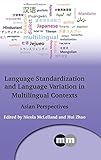Language Standardisation and Language Variation in Multilingual Contexts : Asian Perspectives / ed. by Hui Zhao, Nicola McLelland.
Material type: TextSeries: Multilingual Matters ; 171Publisher: Bristol ; Blue Ridge Summit : Multilingual Matters, [2021]Copyright date: ©2022Description: 1 online resource (360 p.)Content type:
TextSeries: Multilingual Matters ; 171Publisher: Bristol ; Blue Ridge Summit : Multilingual Matters, [2021]Copyright date: ©2022Description: 1 online resource (360 p.)Content type: - 9781800411555
- 9781800411562
- online - DeGruyter
| Item type | Current library | Call number | URL | Status | Notes | Barcode | |
|---|---|---|---|---|---|---|---|
 eBook
eBook
|
Biblioteca "Angelicum" Pont. Univ. S.Tommaso d'Aquino Nuvola online | online - DeGruyter (Browse shelf(Opens below)) | Online access | Not for loan (Accesso limitato) | Accesso per gli utenti autorizzati / Access for authorized users | (dgr)9781800411562 |
Frontmatter -- Contents -- Contributors -- Note on the Use of Original Scripts in this Volume -- Introduction: Language Standardization and Language Variation in Multilingual Contexts – Asian Perspectives -- Part 1 Histories of Standardization in Multilingual Contexts -- 1 Language Codification: Coloniality, Society and History -- 2 Linguistic Variation in Late Qing Western Sources: An Analysis of Edkins’ Grammar of Shanghainese -- 3 Teaching Mandarin Pronunciation to Mongolian Learners in Early Republican Period China: The Case of the Mongolian Han Original Sounds of the Five Regions (Meng Han Hebi Wufang Yuanyin, 蒙漢合璧五方元音) -- Part 2 Standardization and Variation in Multilingual China: Implications for Education, Testing, Policy and Practice -- 4 Reconciling Multilingualism and Promotion of the Standard Language in Education in China -- 5 Language Standards in Language Testing: The Case of Variation in Written Chinese Proficiency Tests for Second Language Learners -- 6 Social Meaning and Variation in Perception: Beijingers’ Attitudes Towards Beijing Mandarin -- 7 Global Chinese and Malaysian Mandarin: Transnational Standards for the Chinese Language -- Part 3: Standardization and Minoritized Languages in Multilingual Contexts -- 8 How Standard Zhuang has Met with Market Forces -- 9 Is Sibe a Linguistic Continuation of Manchu? -- 10 Language Standardization for Tibetans in the People’s Republic of China -- 11 Politeness Strategies, Language Standardization and Language Purism in Amdo Tibetan -- 12 Erasure and Revitalization of an Endangered Language: The Case of Jejueo in South Korea -- 13 Standardizing Indigenous Languages in Thailand Through Orthography Development and Mother Tongue-based Multilingual Education: The Case of Patani Malay -- Part 4 Negotiating Standards and Variation: Case Studies From Japanese -- 14 After Language Standardization: Dialect Cosplay in Japan -- 15 Negotiating ‘Standard’ Gendered Speech in Japanese: The Case of Transgender Speakers -- 16 Between Standardization and Localization: Changes in Tôhoku Dialect as Spoken in Hawai‘i -- Index
restricted access online access with authorization star
http://purl.org/coar/access_right/c_16ec
This book breaks new ground in the study of language standards and standardization through its focus on Asia and in the attention paid to multilingual contexts. The chapters add to our understanding of the ways in which multilingualism is implicated in language standardization, as well as the impact of language standards on multilingualism.
Mode of access: Internet via World Wide Web.
In English.
Description based on online resource; title from PDF title page (publisher's Web site, viewed 25. Jun 2024)


